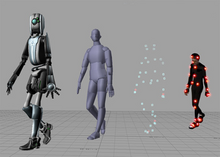| This article needs additional citations for verification. Please help improve this article by adding citations to reliable sources. Unsourced material may be challenged and removed. Find sources: "Micropolygon" – news · newspapers · books · scholar · JSTOR (March 2020) (Learn how and when to remove this message) |
| Three-dimensional (3D) computer graphics |
|---|
 |
| Fundamentals |
| Primary uses |
| Related topics |
In 3D computer graphics, a micropolygon (or μ-polygon) is a polygon that is very small relative to the image being rendered. Commonly, the size of a micropolygon is close to or even less than the area of a pixel. Micropolygons allow a renderer to create a highly detailed image.
The concept of micropolygons was developed within the Reyes algorithm, in which geometric primitives are tessellated at render time into a rectangular grid of tiny, four-sided polygons. A shader might fill each micropolygon with a single color or assign colors on a per-vertex basis. Shaders that operate on micropolygons can process an entire grid of them at once in SIMD fashion. This often leads to faster shader execution, and allows shaders to compute spatial derivatives (e.g. for texture filtering) by comparing values at neighboring micropolygon vertices.
Furthermore, a renderer using micropolygons can support displacement mapping simply by perturbing micropolygon vertices during shading. This displacement is usually not limited to the local surface normal but can be given an arbitrary direction.
Further reading
- Robert L. Cook., Loren Carpenter, and Edwin Catmull. "The Reyes image rendering architecture." Computer Graphics (SIGGRAPH '87 Proceedings), pp. 95–102.
- Anthony Apodaca, Larry Gritz: Advanced RenderMan: Creating CGI for Motion Pictures, Morgan Kaufmann Publishers, ISBN 1-55860-618-1
This computer graphics–related article is a stub. You can help Misplaced Pages by expanding it. |